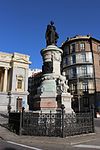Forest of Remembrance

The Forest of Remembrance (Spanish: Bosque del Recuerdo), formerly known as the Forest of the Departed (Bosque de los Ausentes), is a memorial garden located in the park of Parque del Buen Retiro in Madrid, Spain that commemorates the 191 civilian victims of the 2004 Madrid train bombings on the 11th of March 2004 and the special forces agent who died when the seven suicide bombers subsequently killed themselves on March 11th 2004 while under siege by security forces in their apartment block. The new name, Bosque del Recuerdo (Forest of Remembrance), was chosen after the survivors and the victims' families argued that those killed are forever present and have never departed from their hearts. The memorial comprises 192 olive trees and cypresses, one for each person killed, and is surrounded by a channel of water intended to symbolise life. The location is a hillock near the Atocha railway station, one of the sites of the atrocities.
Excerpt from the Wikipedia article Forest of Remembrance (License: CC BY-SA 3.0, Authors, Images).Forest of Remembrance
Calle de Alfonso XII, Madrid Retiro
Geographical coordinates (GPS) Address External links Nearby Places Show on map
Geographical coordinates (GPS)
| Latitude | Longitude |
|---|---|
| N 40.411944444444 ° | E -3.6869444444444 ° |
Address
Bosque del Recuerdo
Calle de Alfonso XII
28014 Madrid, Retiro
Community of Madrid, Spain
Open on Google Maps











